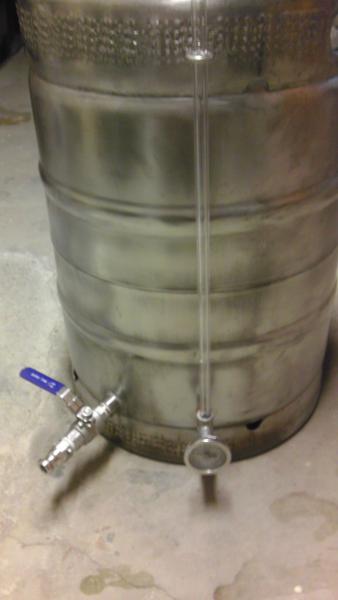Just for good measure and future readers, I'm pasting in the text on my instructions page on drilling stainless. This is collective knowledge from a couple years of drilling for other people and supporting customers on their own projects.
Drilling stainless steel is a tricky maneuver if you haven't done it before but you'll get through it if you take your time and heed all warnings and tips here.
Lay the pot/keg on its side on a piece of cardboard or old carpet on the floor. Line the interior of the pot/keg with a rag, newspaper or a towel to catch lubricant and shavings for easier cleanup.
The first step is to make a tiny divot or depression at the centerpoint where you intend to drill. A pointed center punch and hammer is preferred but if you don't have one, you can use a 10 penny nail. This keeps the bit from wandering across the surface. We recommend first drilling a "pilot" hole of approximate 1/8". Step bits are not great at making that first piercing cut.
Fill a shot glass or similar sized cup with vegetable oil, chuck the step bit into your drill, dip the bit about half way into the oil, position over the 1/8" predrilled hole and apply a firm pressure when you start the drill. After you reach each new step on the bit, stop. Dip the bit back into the oil and let it drip off before drilling the next step. Don't make the mistake of overdrilling the diameter. The WL bulkhead and any other 1/2" NPT penetrations require a 7/8" hole.
While you're drilling, it's best to have someone help by holding the vessel stable. Hold the drill firmly and even prop the back of the drill against your thigh if you can so that if the bit grabs and tries to rotate the drill motor in your hands, you don't hurt your wrists.
Technique Tips and Tools:
The general mantra for drilling stainless is heavy pressure and slow speed. As the step bit turns against the work, it should be slicing a thin ribbon of material away the entire time. If the bit is spinning but NOT cutting, you run the risk of work hardening the stainless which is wear the bit down almost immediately. One of the biggest problems people have with this job is that their dril does not have enough low speed torque to allow for the pressure required to be applied. In other words, if you push as hard as you should be, some drills bog down. The user will try to overcome this problem by running the drill faster. Stop, stop.... No one likes to admit defeat but you may want to ask a friend or neighbor to borrow their drill. A 12 volt or higher cordless drill/driver that is multiple speed adjustments is highly recommended. The reason these work so well is that their speed adjustability is done with gearing, not a variable trigger squeeze. The low RPM setting provides a LOT of torque while keeping the speed slow. We love the DeWalt XRP series, not that you were shopping for a new drill.
We are being extremely wordy here, but it's important because we've received a lot of complaints about how cheap and dull our step bits are. While they are not the same quality as Klein or Greenlee, those higher end bits would also fail miserably with poor technique and a drill with inadequate torque. If you do not have a high torgue/low speed drill and can't borrow one from somewhere, you'd be much better off finding a plumber or electrician that can use a 1/2" conduit punch on your pot/keg. We have drilled many many holes using these "cheap" step bits and we know for a fact that you can get at least a half dozen holes drilled before you make them paper weights.





